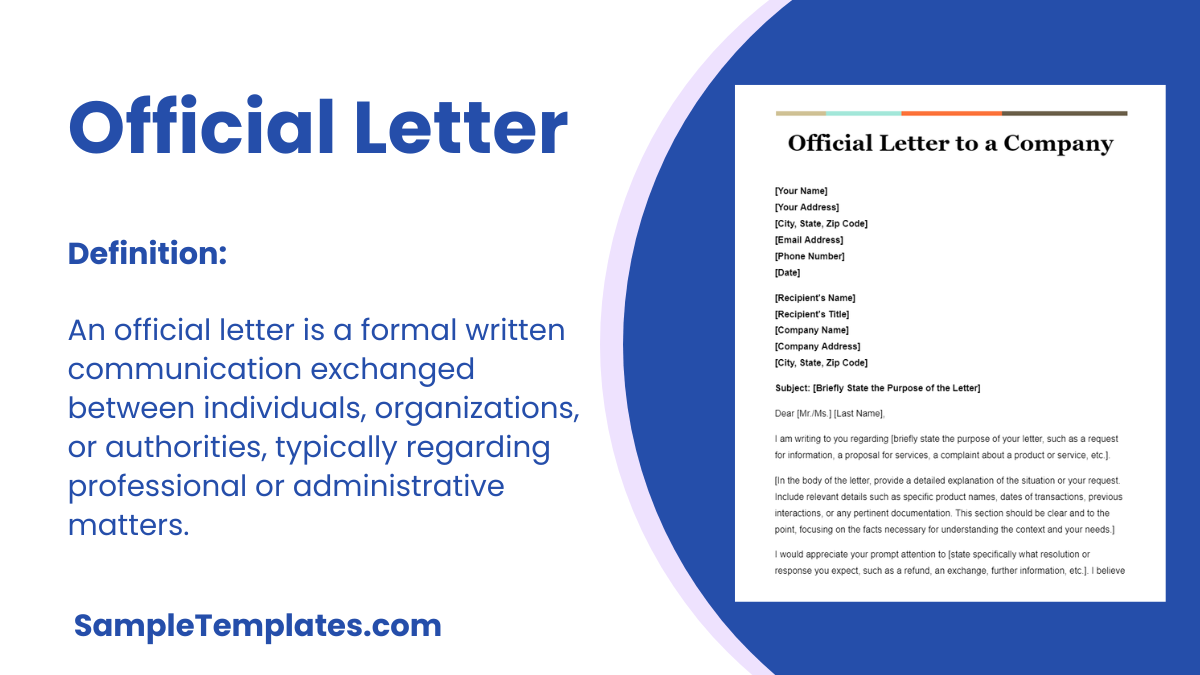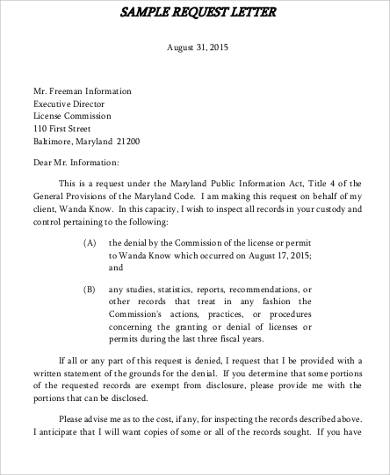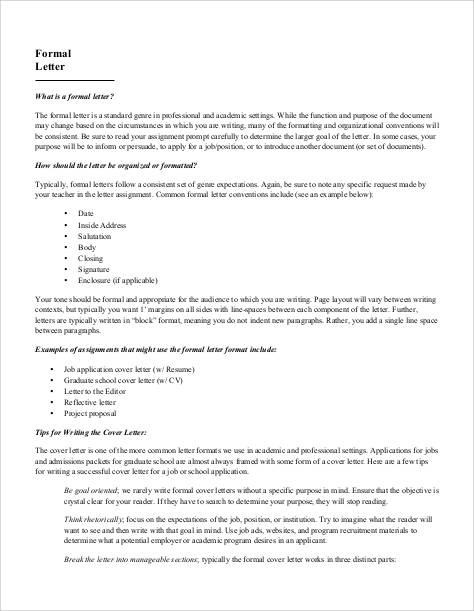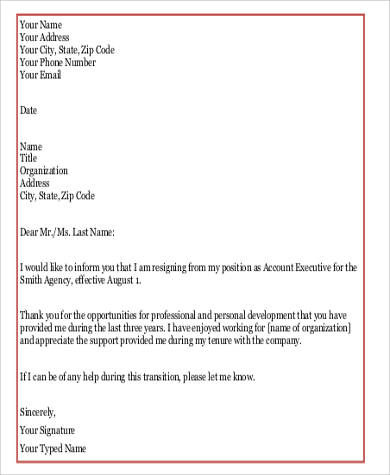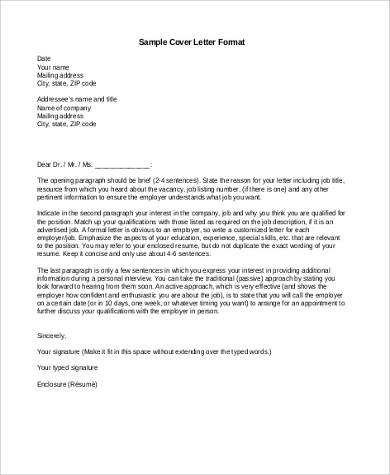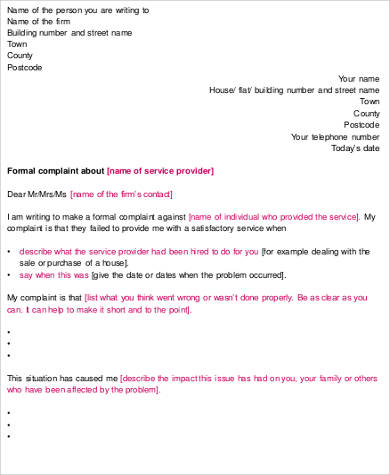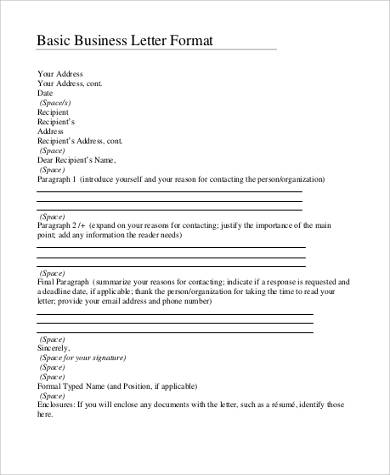Letters may be written for business or non-business purposes. As long as these concerns are deemed to be official, then official letters are to be used for these situations. Official letters are usually used for addressing any type of complaints, requests, queries, permissions, etc. These are used to convey a specific purpose or letter of intent.
There is a standard format that must be followed in writing these letters. The Sample Letters in this article can help you out with the layout and design of your official letter. There are various templates that you can choose from and there sure is one that you can use for the purpose you need it for. Check out the samples below.
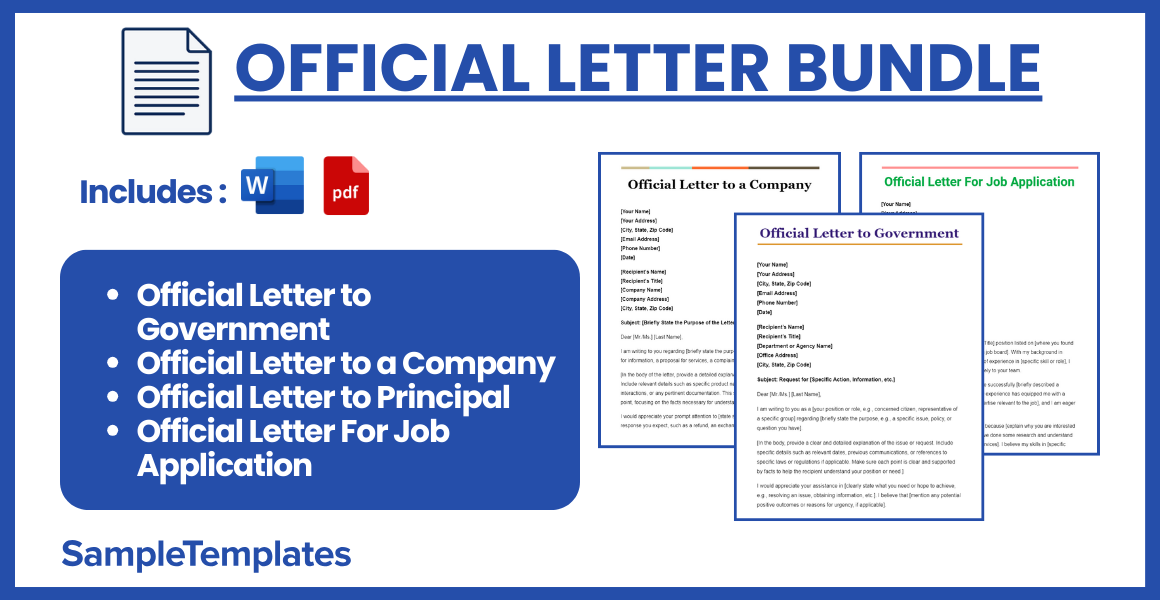
Download Official Letter Bundle
Official Letter to Government
[Your Name]
[Your Address]
[City, State, Zip Code]
[Email Address]
[Phone Number]
[Date]
[Recipient’s Name]
[Recipient’s Title]
[Department or Agency Name]
[Office Address]
[City, State, Zip Code]
Subject: Request for [Specific Action, Information, etc.]
Dear [Mr./Ms.] [Last Name],
I am writing to you as a [your position or role, e.g., concerned citizen, representative of a specific group] regarding [briefly state the purpose, e.g., a specific issue, policy, or question you have].
[In the body, provide a clear and detailed explanation of the issue or request. Include specific details such as relevant dates, previous communications, or references to specific laws or regulations if applicable. Make sure each point is clear and supported by facts to help the recipient understand your position or need.]
I would appreciate your assistance in [clearly state what you need or hope to achieve, e.g., resolving an issue, obtaining information, etc.]. I believe that [mention any potential positive outcomes or reasons for urgency, if applicable].
Thank you for your attention to this matter. I am looking forward to your prompt response. Please feel free to contact me at [your phone number] or [your email address] should you need further information or to discuss this further.
Sincerely,
[Your Signature (if sending a hard copy)]
[Your Printed Name]
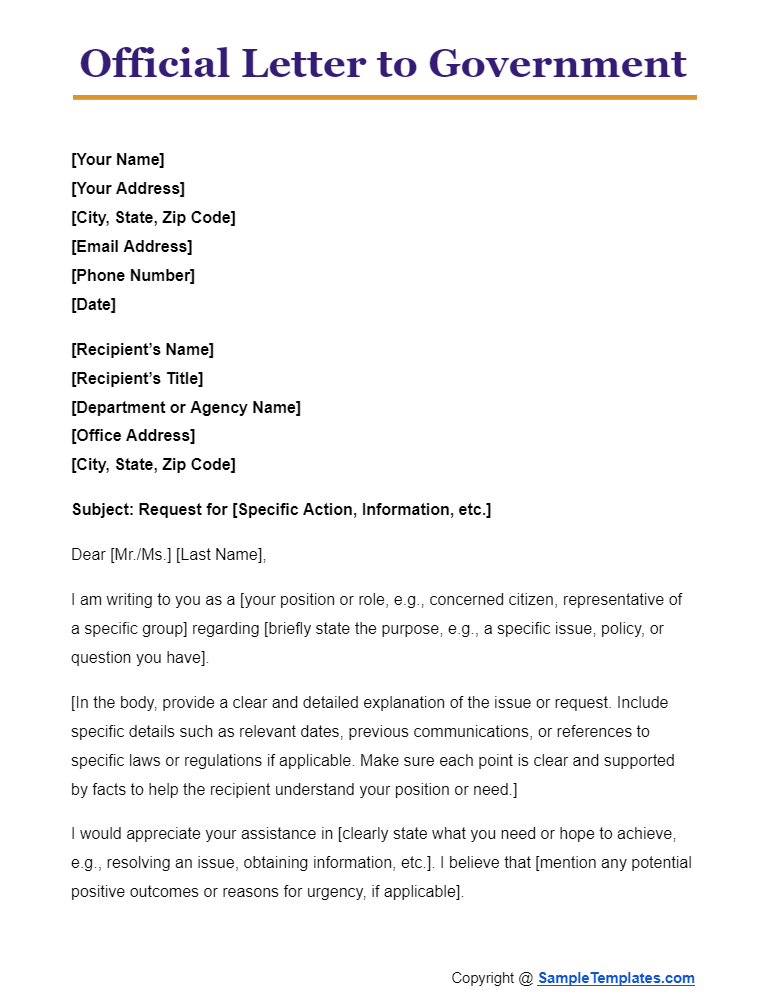
Official Letter to a Company
[Your Name]
[Your Address]
[City, State, Zip Code]
[Email Address]
[Phone Number]
[Date]
[Recipient’s Name]
[Recipient’s Title]
[Company Name]
[Company Address]
[City, State, Zip Code]
Subject: [Briefly State the Purpose of the Letter]
Dear [Mr./Ms.] [Last Name],
I am writing to you regarding [briefly state the purpose of your letter, such as a request for information, a proposal for services, a complaint about a product or service, etc.].
[In the body of the letter, provide a detailed explanation of the situation or your request. Include relevant details such as specific product names, dates of transactions, previous interactions, or any pertinent documentation. This section should be clear and to the point, focusing on the facts necessary for understanding the context and your needs.]
I would appreciate your prompt attention to [state specifically what resolution or response you expect, such as a refund, an exchange, further information, etc.]. I believe that [mention any potential benefits or reasons why the company should consider your request favorably, if applicable].
Please feel free to contact me at your earliest convenience at [your phone number] or [your email address]. I am looking forward to your prompt response and am eager to resolve this matter amicably.
Thank you for your attention to this matter.
Sincerely,
[Your Signature (if sending a hard copy)]
[Your Printed Name]
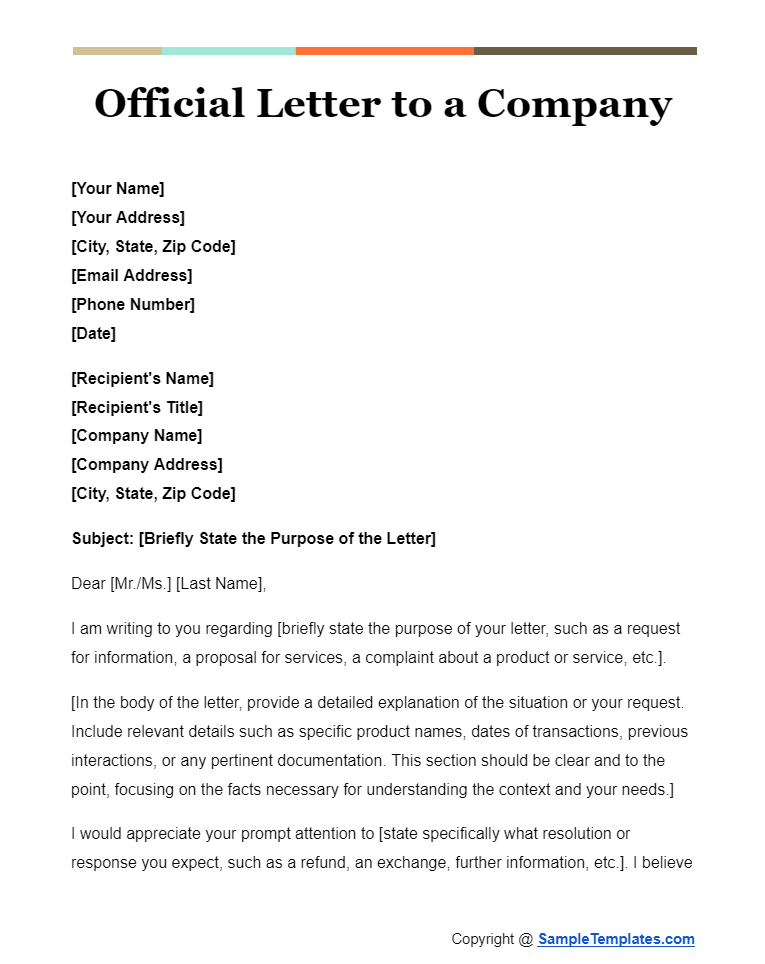
Official Letter to Principal
[Your Name]
[Your Address]
[City, State, Zip Code]
[Email Address]
[Phone Number]
[Date]
[Principal’s Name]
[School Name]
[School Address]
[City, State, Zip Code]
Subject: [Brief Summary of the Letter’s Purpose, e.g., Request for Special Permission, Concern About School Policy, etc.]
Dear Principal [Last Name],
I am [your relationship to the school, e.g., a parent of a student, a teacher, etc.], and I am writing to you regarding [specifically state the purpose of your letter, such as addressing a concern, requesting assistance, proposing a new initiative, etc.].
[In the body, provide a clear and detailed explanation of your concern or request. If relevant, include specific details like dates, names of individuals involved, and any previous discussions or actions related to the matter. Be concise yet thorough in describing the issue and why it requires the principal’s attention.]
I believe that [explain any suggestions you have for resolving the issue or how you would like to see the situation addressed]. I am confident that your understanding and intervention can help us reach a favorable resolution.
I am available to meet at your convenience to discuss this matter further. Please feel free to contact me at [your phone number] or [your email address]. I look forward to your response and appreciate your prompt attention to this important matter.
Thank you for your time and consideration.
Sincerely,
[Your Signature (if sending a hard copy)]
[Your Printed Name]
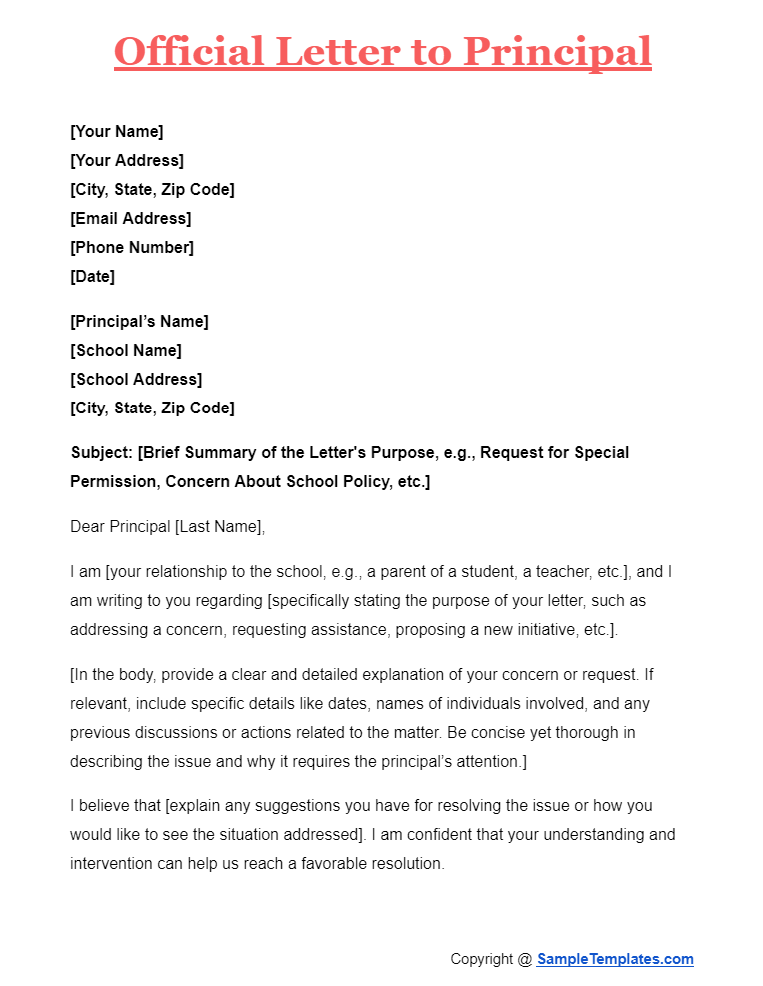
Official Letter For Job Application
[Your Name]
[Your Address]
[City, State, Zip Code]
[Email Address]
[Phone Number]
[Date]
[Recipient’s Name]
[Recipient’s Title]
[Company Name]
[Company Address]
[City, State, Zip Code]
Subject: Application for [Job Title]
Dear [Mr./Ms.] [Last Name],
I am writing to express my interest in the [Job Title] position listed on [where you found the job posting, e.g., the company’s website, a job board]. With my background in [relevant field or industry] and [number] years of experience in [specific skill or role], I am confident in my ability to contribute effectively to your team.
In my current role at [Current Company], I have successfully [briefly describe a relevant accomplishment or responsibility]. My experience has equipped me with a strong foundation in [key skills or areas of expertise relevant to the job], and I am eager to bring my expertise to [Company Name].
I am particularly excited about this opportunity because [explain why you are interested in this company and role, showing that you have done some research and understand the company’s values, mission, or products/services]. I believe my skills in [specific skills] and my passion for [relevant industry or field] make me a strong candidate for this position.
Enclosed with this letter are my resume and [any other relevant documents, such as a portfolio or references]. I would be thrilled to discuss how my background, skills, and enthusiasms can align with the goals of [Company Name]. Please feel free to contact me at [your phone number] or [your email address] to schedule an interview or further discuss my application.
Thank you for considering my application. I look forward to the possibility of contributing to your team and achieving great results together.
Sincerely,
[Your Signature (if sending a hard copy)]
[Your Printed Name]
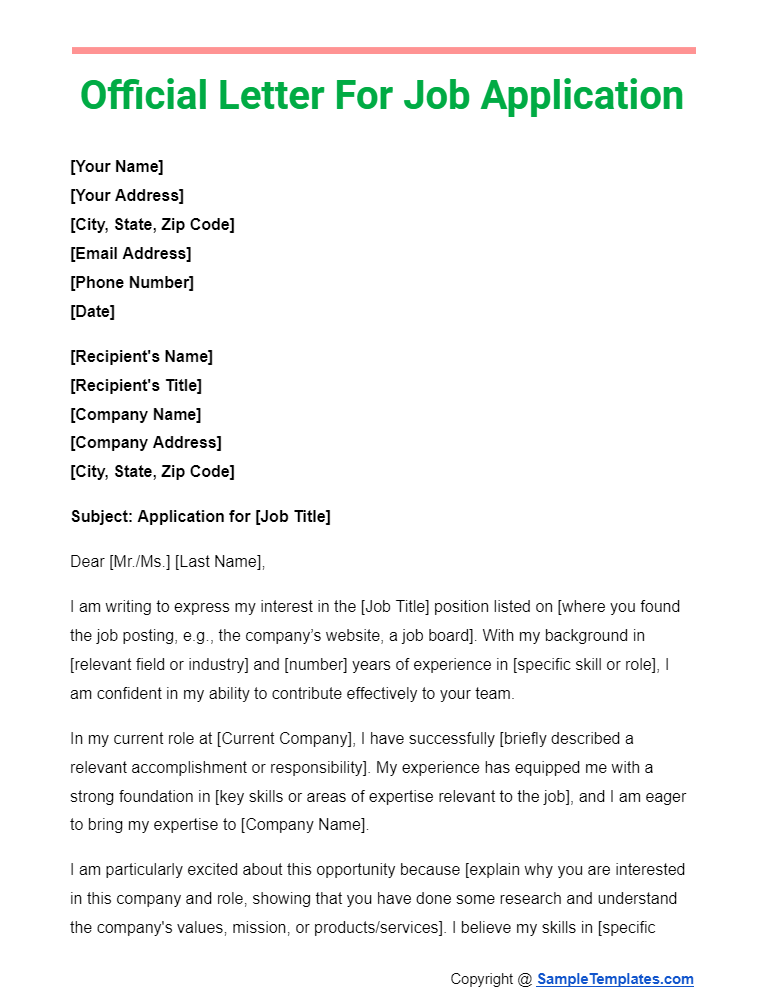
Browse More Templates On Official Letter
Official Leave Letter Template
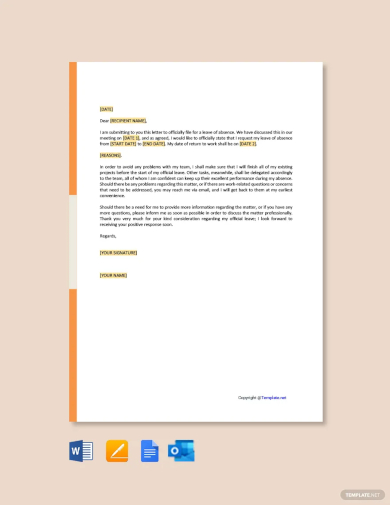
Official Resignation Letter Template
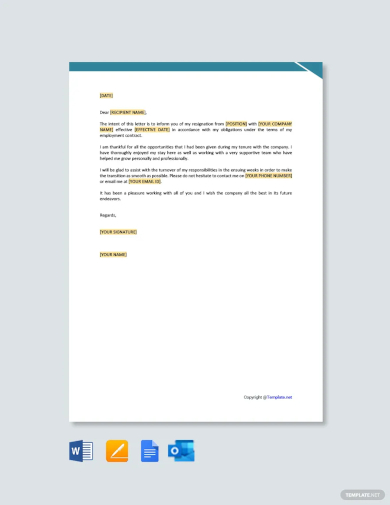
How to Write an Official Letter
Writing an official letter involves following a structured format to ensure clarity and professionalism. Here’s a step-by-step guide to help you craft an effective official letter:
- Choose the Right Format: Official letters typically use a block format where all text is justified to the left and single-spaced, with a double space between paragraphs.
- Include Sender’s Information: At the top of the simple letter, include your name, address, phone number, and email address. If you’re writing on behalf of an organization, use the company’s letterhead.
- Date: Below your contact information, write the date on which the letter is written.
- Recipient’s Information: Add the name, title, organization, and address of the recipient. Ensure that you have the correct spelling and details.
- Subject Line: This should be a brief line summarizing the purpose of the letter. It helps the recipient understand the essence of the message before reading it.
- Salutation: Open with a formal greeting such as “Dear Mr./Ms. [Last Name],” or “To Whom It May Concern,” if you do not know the name of the recipient.
- Body of the Letter:
- Introduction: Briefly introduce yourself (if necessary) and state the main point of the letter.
- Main Content: Explain your reason for writing. Be clear, concise, and include any relevant details to support your purpose.
- Conclusion: Summarize the letter’s main points and indicate any actions needed (e.g., requesting a response, expressing hopes for future collaboration).
- Closing: Use a formal closing such as “Sincerely” or “Respectfully,” followed by a comma.
- Signature: Leave a few spaces for your signature and then type your name. If you’re including any enclosures, type “Enclosures” followed by a colon and the number of enclosures.
- Proofread and Edit: Review your letter for any spelling, grammar, or punctuation errors. Ensure that the tone is appropriate for the context.
By adhering to this structure, you ensure that your official letter is clear, professional, and appropriate for a formal setting.
Official Query Letter Format Template
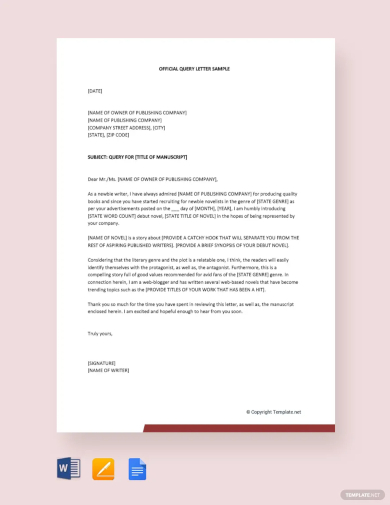
Official Statement Letter Template
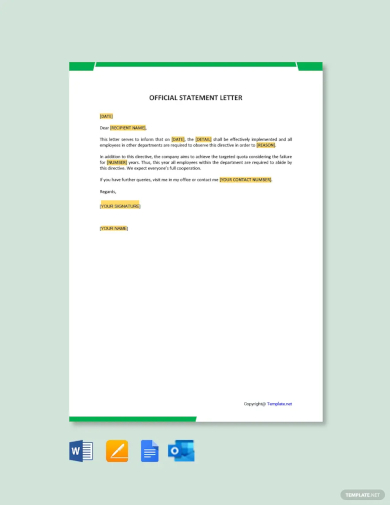
Official Letter for Request Format
Types of Official Letter
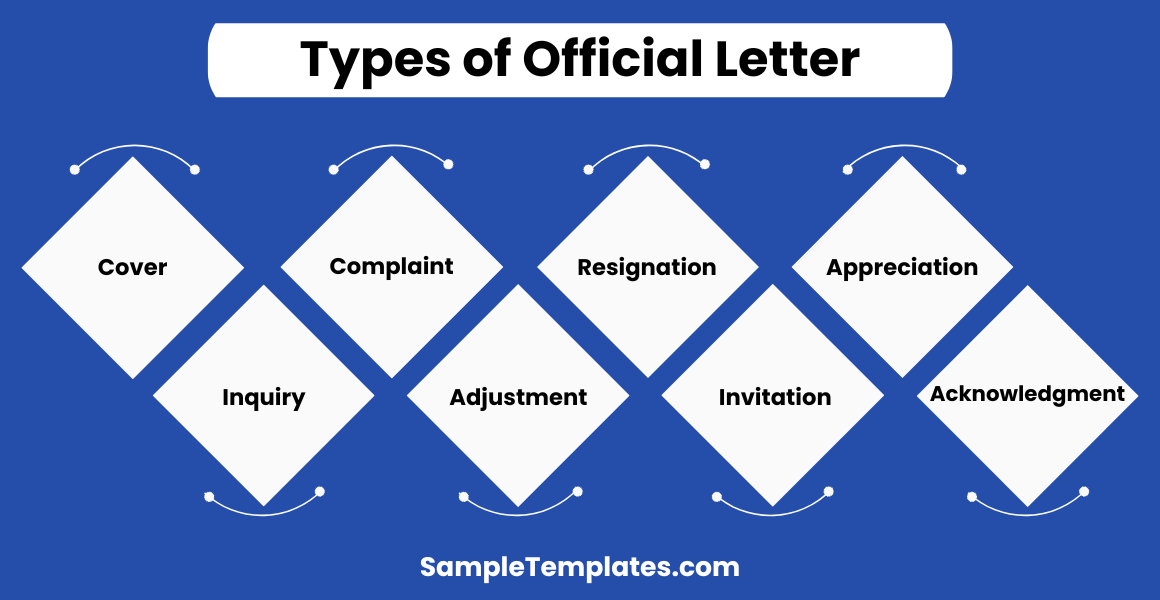
Official letters are diverse, each serving specific functions within professional, governmental, or organizational contexts. Here are some common types of official letters:
- Cover Letter: Accompanies a simple resume or application, providing a personal introduction and a brief overview of one’s qualifications and intentions.
- Business Correspondence Letter: Used for various business interactions such as negotiations, quotations, confirmation of orders, and business proposals.
- Inquiry Letter: Requests information or clarifications from businesses, organizations, or individuals.
- Complaint Letter: Expresses dissatisfaction with a product or service, typically seeking remedial action or a response from the recipient.
- Adjustment Letter: Sent in response to a complaint letter; aims to address the concerns raised and describe the actions taken to correct the issue.
- Recommendation Letter: Provides a professional endorsement of a person’s skills and qualifications, typically for employment or educational opportunities.
- Resignation Letter: Formally communicates the intent to resign from a job position.
- Invitation Letter: Requests the presence of a person or group at an event such as a business meeting, conference, or ceremony.
- Appreciation Letter: Acknowledges the efforts or achievements of an individual or organization, often thanking them for their contributions.
- Acknowledgment Letter: Confirms receipt of items, applications, or documents and sometimes provides additional details about the processing or handling of the received items.
Each type of official letter has its specific format and etiquette, tailored to effectively convey the message while maintaining professionalism and respect for the recipient.
Formal Official Letter Template
Sample Official Resignation Letter Template
The Purpose of Official Letters
- Official letters are a medium of communication between two parties.
- Businesses and individuals can make use of letters for formal proposals, invitations, requests, etc.
- Can be used to appraise or appreciate an individual.
- Important for job applications and job-related tasks—letter of intent, cover letters, post-interview follow-up letter, post-interview thank-you letter, etc.
- Can be used to resolve misunderstandings.
- Can be used as evidence for legal proceedings.
- Can be used to document any type of transaction that occurred between two or more parties.
- Can be used to display a sense of professionalism.
Reminders Regarding an Official Letter
- The first lines of your letter must already state your purpose for writing it.
- You should follow the correct letter format in writing any type of official letter.
- Keep a polite and formal tone throughout your letter.
- Be straightforward and concise. Keep your letter brief template.
- Ensure that you are able to address the recipient if you know who you are sending the letter to.
- If you are sending a hard copy letter, place it in a simple envelope. If you are sending the letter via e-mail, write an appropriate subject line that describes the letter.
You can browse more letter templates at Official Business Letter Format Samples.
Official Cover Letter Format Example
Official Complaint Letter Format
What to Include in an Official Letter
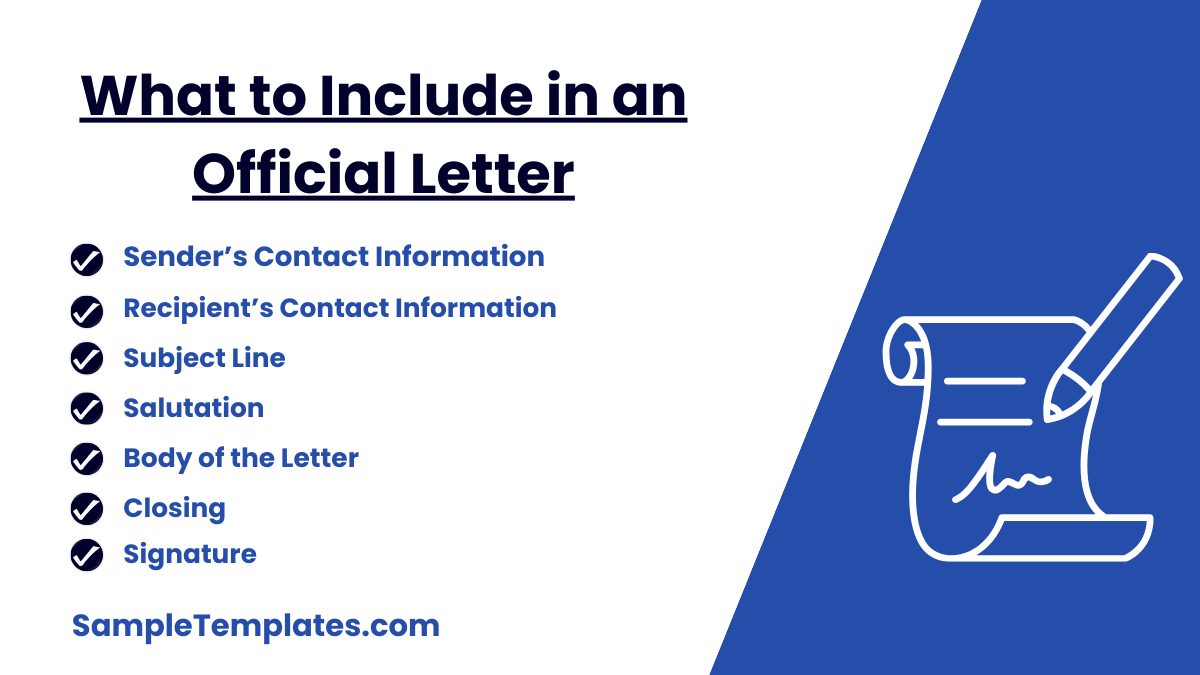
When writing an official letter format, it’s important to include specific elements to ensure clarity, professionalism, and effectiveness. Here are the key components you should incorporate:
- Sender’s Contact Information: Include your name, address, phone number, and email address at the top of the letter. If applicable, use your organization’s letterhead.
- Date: Place the date directly below your contact information, aligned to the left.
- Recipient’s Contact Information: Below the date, include the recipient’s name, title, organization, and address. Make sure all details are accurate.
- Subject Line: Optionally, you can include a subject line to summarize the main point of the sample letter, making it easier for the recipient to understand the purpose at a glance.
- Salutation: Start with a formal greeting using the recipient’s proper title (e.g., Mr., Ms., Dr.) and last name. If you do not know the name, use “Dear Sir/Madam” or “To Whom It May Concern.”
- Body of the Letter:
- Introduction: Begin with a clear statement of purpose. If the letter is unsolicited, introduce yourself briefly.
- Main Content: This section should be clear and to the point. Describe the issue, request, or information that you are addressing. Include relevant details to support your purpose, such as specific data, dates, or reference to previous communications.
- Conclusion: Wrap up your letter by summarizing your points and clearly stating any required actions or requests. If appropriate, mention how you wish to proceed or how you can be contacted.
- Closing: Use a formal closing such as “Sincerely,” “Respectfully,” or “Best regards,” followed by a comma.
- Signature: Leave space for your handwritten signature above your typed name. If the letter is being sent electronically, you may include a digital signature.
- Enclosures: If you are including any documents with the letter, list them under the word “Enclosures.” This alerts the recipient that additional material is included with the letter.
- CC: If you are sending copies to additional individuals, indicate this by including “CC:” followed by their names and titles at the bottom of the letter.
Including all these elements ensures that your official letter is comprehensive, respectful, and tailored to facilitate clear communication.
Sample Official Business Letter Format
Official Letter Application Format
What Not to Include in an Official Letter
When writing an official letter outline, it’s important to maintain a professional tone and focus. Here are some things you should avoid including in an official letter to ensure it remains appropriate and effective:
- Personal Information: Avoid sharing personal details that are not relevant to the purpose of the letter. Keep the content professional and focused on the matter at hand.
- Informal Language: Slang, colloquialisms, and overly casual language can undermine the professional tone of an official letter. Stick to formal language and avoid using contractions (e.g., use “do not” instead of “don’t”).
- Emotional Content: Keep emotions in check. Even if the letter addresses a complaint or a sensitive issue, maintain a calm, professional tone without expressing anger, frustration, or excessive emotion.
- Excessive Length: Be concise. Do not include irrelevant details or ramble. Keep your letter to the point to respect the recipient’s time.
- Errors: Grammatical mistakes, typos, and inaccurate information can detract from your credibility and the effectiveness of your letter. Always proofread your letter before sending it.
- Jargon or Complex Terminology: Unless it is industry-specific and the recipient understands the terms, avoid using jargon or overly complex vocabulary that could confuse the reader.
- Assumptions or Accusations: Do not make assumptions about the recipient’s thoughts, feelings, or motivations. Also, avoid accusatory language as it can be confrontational and unproductive.
- Confidential or Sensitive Information: Unless it is absolutely necessary and you have the right to share it, avoid including confidential or sensitive information about individuals or the company.
- Overly Familiar Closings: Keep your closing formal. Avoid closings that are too familiar or informal for a professional setting, such as “Cheers” or “Love.”
- Demands or Threats: Even if you are making a complaint or demand, phrase it politely as a request. Avoid any language that could be interpreted as a threat.
By avoiding these elements, you ensure that your official letter remains professional, respectful, and targeted toward achieving your communication goals.
Using Official Letter Format Samples
Searching for official letter formats nowadays is very easy with the surge of technology. There are various letter templates that you can choose from in this article that will help out with writing your letters. The template that you will choose will all depend on your needs, preference, and the purpose why you will be writing the said letter. These factors can help you decide on the template that you will be choosing before you click on the green download button.
The official letter formats presented here are all in PDF (.pdf) format. This makes it easy to customize with the right tools and sample applications in your device. Since this file format is very compact, this is also light in size and can be very easy to attach to e-mails and print to personally hand to the recipient. All of these are easily accessible in this article, which means that you can directly download your preferred template without having to redirect to another website. You just need to browse through the samples in this article and pick the one that you can use. You can personalize the letter by changing a few words, customize the fonts, borders, and other aspects of the chosen official letter template.
What is in an official letter?
An official letter includes sender’s contact info, date, recipient’s details, subject line, formal salutation, concise body, formal closing, and signature. It conveys professional, specific information or requests.
What is required for official letter?
Required elements include formal structure, sender and recipient information, date, subject line, courteous greeting, clear message, and a professional closing with a signature.
How do you set out an official letter?
Use block format: left-aligned text, single spacing, double spacing between paragraphs. Include sender and recipient information, date, salutation, body, closing, and signature.
What is the rule of official letter?
Maintain professionalism with a structured format: clear, concise content, formal language, no personal emotions, and appropriate courtesy. Ensure it addresses the recipient respectfully and directly.
Does official letter have a signature?
Yes, an official letter typically includes a signature. This is part of the closing section, providing authentication and personal acknowledgment of the letter’s content.
In conclusion, we appreciate your prompt attention to this matter. Your cooperation will ensure smooth proceedings. We look forward to a favorable resolution. Thank you for your understanding and cooperation.
You can also browse through other formats in the Official Letter Formats article.
Related Posts
Resignation Letter for Medical Samples & Templates
Letter of Intent Samples & Templates
Letter of Intent for a Job Samples & Templates
Lease Proposal Letter Samples & Templates
Letter of Inquiry Samples & Templates
Character Reference Letter Samples & Templates
Claims Letter Samples & Templates
Response Letter Sample & Templates
Follow Up Letter Samples & Templates
Sample Project Proposal Letter Templates
Donation Letter Samples & Templates
Addressing a Formal Letter Samples & Templates
Grievance Letter Samples & Templates
Sample Sponsor Thank You Letter Templates
Sample Letters of Request
